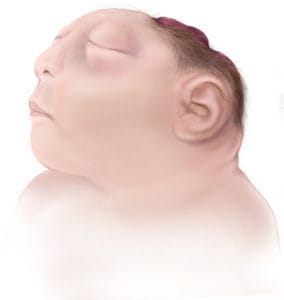Contents:
- Medical Video: Neural Tube Defects - What You Need To Know
- What is anencephaly?
- How common is anencephaly?
- Anencephaly is a neural tube defect. What is the reason?
- How is anencephaly diagnosed?
- How likely is the baby anencephaly to survive?
- Can anencephaly be treated?
- Can anencephaly be prevented?
Medical Video: Neural Tube Defects - What You Need To Know
Every parent wants their child to be born into the world with perfect physique. Therefore, it is certainly not an easy matter for parents to face the fact that their babies are born disabled. Anencephaly is one of the most common types of birth defects - sometimes even fatal. One in 1,000 pregnancies has a great chance of experiencing this pregnancy complication. Here's a complete review of anencephaly that all parents need to know.
What is anencephaly?
Anencephaly is a serious birth defect that causes a baby to be born without a part of his brain and skull. Anencephaly is a type of neural tube defect. The neural tube is an embryonic structure that eventually develops into the baby's brain and skull, as well as the spinal cord and other tissues that accompany it. Nerve tubes usually form early in pregnancy and close on the 28th day after fertilization.
Anencephaly occurs when the top of the nerve tube fails to close completely. As a result, the developing brain's brain and spinal cord are exposed to the amniotic fluid that surrounds the fetus in the womb. Exposure to amniotic fluid then causes the nervous system tissue to decompose and disintegrate.

This results in the baby being born without a part of the brain called the cerebrum and the cerebellum. This area of the brain is needed to think, hear, see, emotion, and coordinate movements. The skull bones are also partially lost or not completely formed. This causes the remaining part of the brain often not covered by bones or skin.
How common is anencephaly?
Anencephaly is a fairly common complication of pregnancy. However, the exact number is unknown because many pregnancies involving neural tube defects end in a miscarriage or stillbirth. About one in 1,000 pregnancies is likely to experience this. According to the CDC, 3 out of 10 thousand pregnancies in the United States each year are diagnosed with anencephaly. This means that there are approximately 1,206 pregnancies in the United States that are affected by anencephaly every year.
Anencephaly is more common in newborn babies than men, with a ratio of 3 to 2. This may be due to cases of spontaneous abortion or higher stillbirths among male fetuses.
In about 90 percent of cases, parents of anencephaly babies do not have a family history of this disorder. However, if parents have had children born with anencephaly, they have a greater chance of having another baby with this condition. However, the recurrence rate is quite low at 4 to 5 percent. This risk can increase up to 10 to 13 percent if parents have two previous children with anencephaly.
Anencephaly is a neural tube defect. What is the reason?
Not all cases of anencephaly are known exactly what causes it. Some babies are born with anencephaly because of changes in their genes or chromosomes. The most studied of these genes is MTHFR, a gene that provides instructions for making proteins involved in processing vitamin folate (also called vitamin B9). Lack of folic acid is a strong risk factor for neural tube defects.
Anencephaly may also be caused by a combination of genes and other factors, such as things related to the mother in her environment or what she ate or drank, or certain drugs she used during pregnancy. Other maternal risk factors for anencephaly include damaged amniotic fluid, diabetes, obesity, high heat exposure (such as fever or a hot tub or sauna) in early pregnancy, and the use of certain anti-seizure drugs during pregnancy. However, it is not clear how these factors can affect the risk of anencephaly.
It is also known that fathers who are over 40 years old while planning a pregnancy, as well as food intake and lifestyle patterns (for example, drinking alcohol), play an important role in causing impaired fetal growth and development.
How is anencephaly diagnosed?
Anencephaly can be diagnosed during pregnancy or after the baby is born. During pregnancy, there is a prenatal screening test to check for birth defects and other conditions. Anencephaly will result in abnormal results in a blood screening test or AFP (alpha fetoprotein) serum, or may be seen at ultrasound (which will show a picture of the baby's body). If your pregnancy is at high risk for anencephaly, screening should take place between the 15th and 20th weeks, with the best time being in the 16th week.
In some cases, anencephaly is only seen when the baby is born.
How likely is the baby anencephaly to survive?
Anencephaly is a very severe nervous system defect. Almost all babies diagnosed with anencephaly die while still in the womb. Even if the baby survives in the womb, about 40% of babies with anencephaly are born prematurely, but are at high risk of dying within a few hours or days after birth. In rare cases, children with anencephaly can live for weeks to months.
Can anencephaly be treated?
There is no standard cure or treatment for anencephaly babies. Almost all babies born with anencephaly will die shortly after birth.
However, survivors will be given supportive care. Babies will be kept warm in the incubator, and the area of the vulnerable brain will be protected. Sometimes special bottles are used to help feed babies who may have difficulty swallowing breast milk.
Can anencephaly be prevented?
Getting enough folic acid before and during early pregnancy can help prevent neural tube defects, such as anencephaly. Women of childbearing age are recommended to consume 0.4 mg of folic acid every day, both through food intake and supplements. Folic acid is also important even if you do not intend to get pregnant. This is just in case, because neural tube defects are formed very early in pregnancy, often before women realize that they are pregnant.
Women who have had previous pregnancies affected by neural tube defects are advised to consume 4 mg of folic acid which begins 30 days before conception until the first trimester under the care of their doctor.
But do not consume folic acid more than 1 mg, unless advised by such a doctor. A high dose of folic acid can mask the diagnosis of pernicious anemia caused by B12 deficiency.












